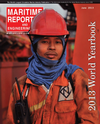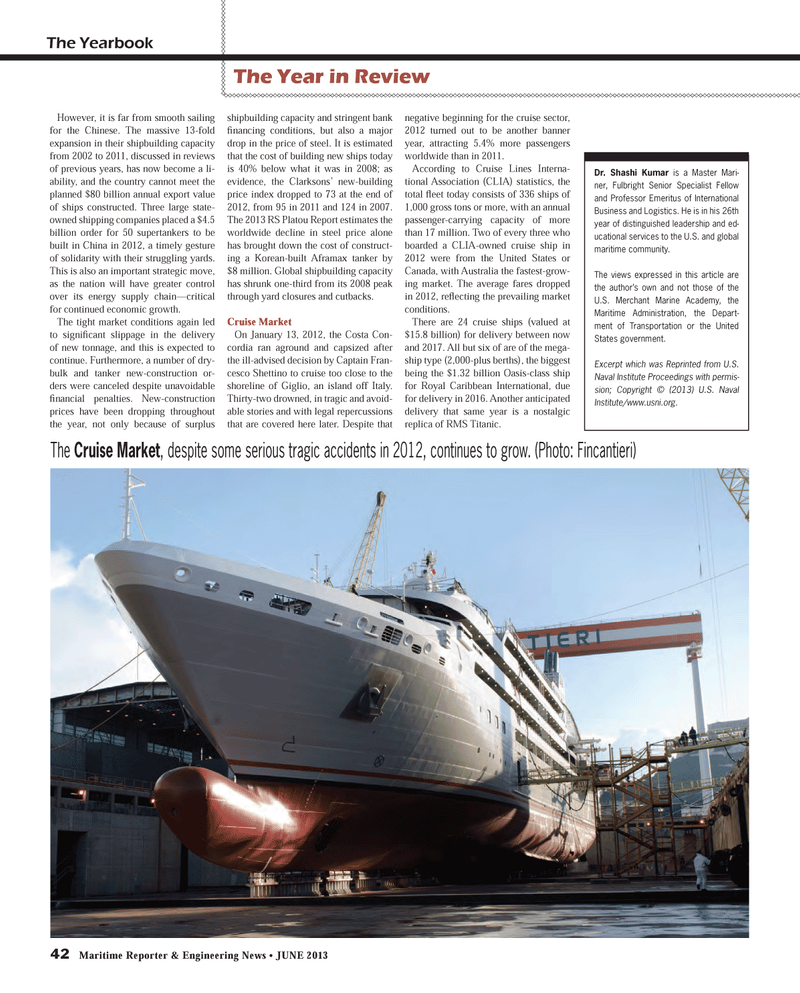
Page 42: of Maritime Reporter Magazine (June 2013)
Annual World Yearbook
Read this page in Pdf, Flash or Html5 edition of June 2013 Maritime Reporter Magazine
42 Maritime Reporter & Engineering News ? JUNE 2013 However, it is far from smooth sailing for the Chinese. The massive 13-fold expansion in their shipbuilding capacity from 2002 to 2011, discussed in reviews of previous years, has now become a li-ability, and the country cannot meet the planned $80 billion annual export value of ships constructed. Three large state- owned shipping companies placed a $4.5 billion order for 50 supertankers to be built in China in 2012, a timely gesture of solidarity with their struggling yards. This is also an important strategic move, as the nation will have greater control over its energy supply chain?critical for continued economic growth.The tight market conditions again led to signiÞ cant slippage in the delivery of new tonnage, and this is expected to continue. Furthermore, a number of dry-bulk and tanker new-construction or- ders were canceled despite unavoidable Þ nancial penalties. New-construction prices have been dropping throughout the year, not only because of surplus shipbuilding capacity and stringent bank Þ nancing conditions, but also a major drop in the price of steel. It is estimated that the cost of building new ships today is 40% below what it was in 2008; as evidence, the Clarksons? new-building price index dropped to 73 at the end of 2012, from 95 in 2011 and 124 in 2007. The 2013 RS Platou Report estimates the worldwide decline in steel price alone has brought down the cost of construct-ing a Korean-built Aframax tanker by $8 million. Global shipbuilding capacity has shrunk one-third from its 2008 peak through yard closures and cutbacks.Cruise MarketOn January 13, 2012, the Costa Con-cordia ran aground and capsized after the ill-advised decision by Captain Fran-cesco Shettino to cruise too close to the shoreline of Giglio, an island off Italy. Thirty-two drowned, in tragic and avoid-able stories and with legal repercussions that are covered here later. Despite that negative beginning for the cruise sector, 2012 turned out to be another banner year, attracting 5.4% more passengers worldwide than in 2011. According to Cruise Lines Interna-tional Association (CLIA) statistics, the total ß eet today consists of 336 ships of 1,000 gross tons or more, with an annual passenger-carrying capacity of more than 17 million. Two of every three who boarded a CLIA-owned cruise ship in 2012 were from the United States or Canada, with Australia the fastest-grow- ing market. The average fares dropped in 2012, reß ecting the prevailing market conditions. There are 24 cruise ships (valued at $15.8 billion) for delivery between now and 2017. All but six of are of the mega- ship type (2,000-plus berths), the biggest being the $1.32 billion Oasis-class ship for Royal Caribbean International, due for delivery in 2016. Another anticipated delivery that same year is a nostalgic replica of RMS Titanic. The YearbookThe Year in ReviewThe Cruise Market, despite some serious tragic accidents in 2012, continues to grow. (Photo: Fincantieri) Dr. Shashi Kumar is a Master Mari-ner, Fulbright Senior Specialist Fellow and Professor Emeritus of International Business and Logistics. He is in his 26th year of distinguished leadership and ed-ucational services to the U.S. and global maritime community. The views expressed in this article are the author?s own and not those of the U.S. Merchant Marine Academy, the Maritime Administration, the Depart- ment of Transportation or the United States government.Excerpt which was Reprinted from U.S. Naval Institute Proceedings with permis- sion; Copyright © (2013) U.S. Naval Institute/www.usni.org. MR #6 (42-49).indd 42MR #6 (42-49).indd 425/30/2013 1:18:12 PM5/30/2013 1:18:12 PM

 41
41

 43
43
